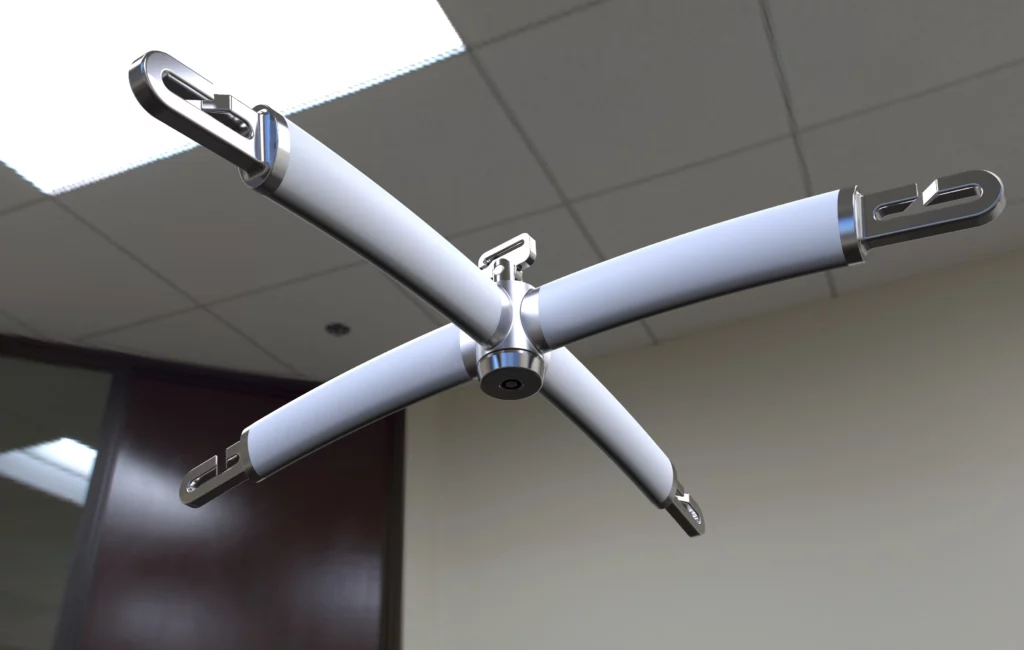A Guide to Ceiling Hoist Spreader Bars
Once your hoist system is installed, setup, and ready to use, there are a few other options to consider. One of these being spreader bars.
Spreader bars come in various shapes and sizes and offer many different benefits to all kinds of users. So, which is the right one for your client?
What are spreader bars?
Spreader bars connect to the tape of the hoist unit and provide a stable structure to hang a sling from. This gives a more balanced and supportive lift to the user.
Understandably, spreader bars need to cater to a lot of different users and a lot of different slings. They will either come with loop or clip fixings depending on the kind of sling you use, and they differ in shape and size to offer different kinds of positioning and support for a multitude of needs.
Bars with loop fixings tend to be more common because of the sheer variety of slings that use loop attachments. Slings are often fixed with several loops on each strap to give you flexibility in positioning when lifting the individual.
However, some slings and bars use clip fixings. These tend to be a little shorter in length, meaning that the spreader bar has to be brought down further — often being held right in front of the individual’s face.
There are less positioning options with a clip fixing slings, but it can help to tilt a person which is useful when moving someone to a seat. You can actually see the clip fixing attach to the spreader bar securely, and it’s most often used with a powered wishbone model.

4 point spreader bar
Choosing for a Bariatric User
When selecting a spreader bar to use with a bariatric or plus-sized patient, one of the biggest issues that comes up is the fact that the patient still gets squashed in the sling. A traditional 2-point spreader bar doesn’t always cut it, so we recommend using a 4-point cross spreader bar instead.
The 4-point spreader bar provides a bigger surface area to lift from, which is great for bariatric users. The spreader bars are fixed perpendicular to one another which spreads the sling out for a more comfortable transfer. This gives any plus-sized patient much more comfort and dignity when being hoisted.
The Best Spreader Bar for Paediatric Patients
When selecting a paediatric spreader bar, we always suggest choosing a 2-point model. However, with paediatric users or smaller individuals, it would be better to use a smaller 2-point spreader bar.
You can get paediatric versions that are about 30-40cm wide (a standard one is about 50-60cm in width), which fits a child’s body much more securely.
As you can imagine, putting a child into an adult size sling with a standard size spreader bar won’t offer them the correct support and it could actually put them in harm’s way should they slip out of the sling altogether.
Using a shorter spreader bar makes the sling narrower, which fits more snugly to a child’s body. This will help to keep the patient cradled comfortably in the sling and reduce the risk of them slipping out of it.
Spreader Bars to Move from a Seated to Laying Position
For someone who cannot move from seated to laying and vice versa, you need a bar that can facilitate different ranges of movement for different parts of the body. For this, we would say an electric wishbone spreader bar is an ideal option.
The wishbone shape gives the carer the ability to lift both ends of the body at different speeds, which then moves the patient to a seated or lying position. Using an electric spreader bar also makes it easier for the carer to alter the position of the patient with little effort.
The hoist handset can be used to adjust the position of the legs, whilst the upper body is cradled securely in the sling.
Hoisting Patients in Critical Care Units
Moving and transferring patients in critical care or high dependency units can be a real obstacle, and hoist equipment selection is key. For transfers like this, you need to make sure that the patient is kept in a stable and supported position at all times — and this often means keeping them laid flat.
A supine stretcher is ideal for this. The stretcher is securely fastened to the hoist unit, and lifts the patient with ease, keeping them level and comfortable whilst elevated.
This gives carers time to carry out any hygiene procedures or change bedding.
The supine stretcher is ideal for patients who may have open wounds or other medical issues which require them to stay relatively still. It’s usually made from metal to maintain good levels of infection control.
Check out our other blogs on hoisting equipment
How do I choose the right ceiling track hoist system?
How to choose the right patient lifting hoist sling
Five things to check before using a ceiling track hoist
What makes healthcare equipment good for infection prevention?
Can we help with anything?
Be sure to use the contact form and reach out to us if you have any questions about the content above.